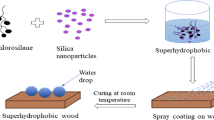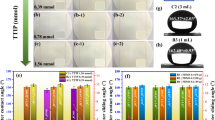Abstract
In this work, first time anti-wetting coating on wood surface is prepared by using titanium dioxide (TiO2) nanoparticles and low carbon chain fatty acid (butyric acid). By combining TiO2 nanoparticles and butyric acid, superhydrophobicity is achieved with water static contact angle of 168 ± 2° and tilt angle of 6 ± 1°. Coating exhibits the excellent anti-dust and anti-stain properties. Coating is found to be mechanical, thermally, UV and chemically stable after performing water jet, sand abrasion, annealing, sun light exposure and chemical stability tests. Additionally present study also shows that coated surface attains sticky superhydrophobicity at high impact velocity. We envision that the durable superhydrophobic coating of TiO2 nanoparticles and butyric acid can be effective for anti-dust and anti-stain properties of wood surface and aforesaid coating has great industrial and household applications.










Similar content being viewed by others
References
Cassie ABD, Baxter S (1944) Wettability of porous surfaces. Trans Faraday Soc 40:546–551
Chauhan P, Kumar A, Bhushan B (2018) Self-cleaning, stain-resistant and anti-bacterial superhydrophobic cotton fabric prepared by simple immersion technique. J Colloid Interface Sci 535:66–74
Hsieh CT, Chang BS, Lin JY (2011) Improvement of water and oil repellency on wood substrates by using fluorinated silica coating. Appl Surf Sci 257:7997–8002
Jia S, Chen H, Luo S, Qing Y, Deng S, Yan N, Wu Y (2018) One-step approach to prepare superhydrophobic wood with enhanced mechanical and chemical durability: Driving of alkali. Appl Surf Sci 455:115–122
Lomga J, Varshney P, Nanda D, Satapathy M, Mohapatra SS, Kumar A (2017) Fabrication of durable and regenerable superhydrophobic coatings with excellent self-cleaning and anti-fogging properties for aluminium surfaces. J Alloys Compd 712:161–170
Liu F, Wang S, Zhang M, Ma M, Wang C, Li J (2013) Improvement of mechanical robustness of the superhydrophobic wood surface by coating PVA/SiO2 composite polymer. Appl Surf Sci 280:686–692
Martins P, Costa CM, Belenmikki M, Lanceros-Mendez S (2012) Nanoparticle dispersion and electroactive phase content in polyvinylidene fluoride/Ni0.5Zn0.5Fe2O4 nanocomposites for magnetoelectric applications. J Nanosci Nanotechnol 12:6845–6849
Nanda D, Kumar A (2019) Methods and fabrication techniques of superhydrophobic surfaces. In: Samal S, Mohanty S, Nayak SK (eds) Superhydrophobic polymer coatings. Elsevier, Amsterdam
Pandit SK, Tudu BK, Mishra IM, Kumar A (2020) Development of stain resistant, superhydrophobic and self-cleaning coating on wood surface. Prog Org Coat 139:105453
Reinprecht L (2016) Wood deterioration, protection and maintenance. Wiley, West Sussex
Rua M, Wang JW, Liu QL, Ma FM, Yu ZL, Feng W, Chen Y (2016) Superhydrophobic and anti-icing properties of sol–gelprepared alumina coatings. Russ J Non-Ferrous Met 57:638–645
Shah SM, Zulfiqar U, Hussain SZ, Ahmad I, Hussain I, Subhani T (2017) A durable superhydrophobic coating for the protection of wood materials. Mater Lett 203:17–20
Tu K, Wang X, Kong L, Guan H (2018) Facile preparation of mechanically durable, self-healing and multifunctional superhydrophobic surfaces on solid wood. Mater Des 140:30–36
Varshney P, Nanda D, Mohapatra SS, Kumar A (2017) A facile modification of steel mesh for selective separation of oil–water mixtures. RSC-New J Chem 41:7463–7471
Wan C, Jiao Y, Wei S, Zhang L, Wu Y, Li J (2019) Functional nanocomposites from sustainable regenerated cellulose aerogels: a review. Chem Eng J 359:459–475
Wan C, Jiao Y, Lian L (2020) In situ deposition of graphene nanosheets on wood surface by one-pot hydrothermal method for enhanced UV-resistant ability. Appl Surf Sci 347:891–897
Wang S, Liu C, Liu G, Zhang M, Li J, Wang C (2011) Fabrication of superhydrophobic wood surface by a sol–gel process. Appl Surf Sci 258:806–810
Wang S, Shi J, Liu C, Xie C, Wan C (2011b) Fabrication of a superhydrophobic surface on a wood substrate. Appl Surf Sci 257:9362–9365
Wanag A, Rokicka P, Nejman EK, Kozar JK, Wrobel RJ, Szczupak AM, Morawski AW (2018) Antibacterial properties of TiO2 modified with reduced graphene oxide. Ecotoxicol Environ Saf 147:788–793
Xie L, Tang Z, Jiang L, Breedveld V, Hess DW (2015) Creation of superhydrophobic wood surfaces by plasma etching and thin-film deposition. Surf Coat Technol 281:125–132
Author information
Authors and Affiliations
Corresponding author
Ethics declarations
Conflict of interest
There is no conflict to declare.
Additional information
Publisher’s note
Springer Nature remains neutral with regard to jurisdictional claims in published maps and institutional affiliations.
Electronic Supplementary Material
Below is the link to the electronic supplementary material.
Supplementary Material 1
Rights and permissions
About this article
Cite this article
Kumar, A., Tudu, B.K. & Pandit, S.K. Development of novel anti‐wetting coating on cellulosic surface using low carbon butyric acid. Cellulose 28, 4825–4834 (2021). https://doi.org/10.1007/s10570-021-03797-8
Received:
Accepted:
Published:
Issue Date:
DOI: https://doi.org/10.1007/s10570-021-03797-8




